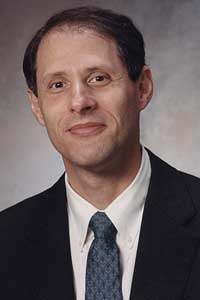Rosenbaum leads team measuring quantum effects in real-world objects
By Steve KoppesNews Office
 Thomas Rosenbaum, the James Franck Professor in Physics and the College and Vice President for Research and for Argonne National Laboratory. |
The paradoxical influence of quantum mechanics dominates the microscopic world, yet rarely seems to show itself in the world of everyday life. Now University physicists have demonstrated a new way of measuring the phenomenon’s effects in an object large enough to hold in their hands.
Measuring quantum effects in real-world objects is an important steppingstone toward building quantum computers, which would be vastly more powerful than today’s computers. In their experiment, the researchers measured the macroscopic effects of quantum mechanics by applying a magnetic field and heat to a half-inch square salt crystal made of a lithium compound and wrapped in a loop of wire.
“This is not a quantum computer, but it addresses some of the fundamental issues that will need to be solved if we’re ever going to build one,” said Thomas Rosenbaum, the James Franck Professor in Physics and the College and Vice President for Research and for Argonne National Laboratory.
Rosenbaum and co-authors Sayantani Ghosh (Ph.D., ’03), now at the University of California, Santa Barbara; Gabriel Aeppli of University College London, and Susan Coppersmith of the University of Wisconsin, Madison, describe the system in a recent issue of the journal Nature.
In the weird world of quantum mechanics, objects can exist simultaneously in mutually exclusive states, but with a certain probability that one state or another will apply at a given moment. This ability for information to exist in multiple states at once is what would make a quantum computer so powerful. In modern digital computers, a bit of information can exist in only one of two states: zero or one. In a quantum computer, a qubit could exist as either zero or one or both at the same time, which translates into faster speeds because of the possibility of processing huge amounts of information in parallel.
The experimenters chose the lithium compound for their tests because its magnetic properties are well understood. The response of the atoms in the compound to the application of heat and magnetism then betrayed the invisible hand of quantum mechanics.
“Quite often quantum entanglement is probably the cause of macroscopically observable effects, but in general it is difficult to identify exactly which macroscopic features are the result of microscopic entanglement,” Coppersmith said.
The team’s computer simulations show that under the laws of physics that ordinarily dominate behavior at the macroscopic level, the magnetic alignment of the atoms in the salt crystal should respond similarly to both higher temperatures and higher magnetic fields. But the team’s experiment showed no such correlation between the two measurements.
“It was because of the entanglement that those two quantities, which should look roughly the same, actually look different,” Rosenbaum said.
The experiment possibly opens the way to the development of quantum computers using solid materials-in this case magnets-instead of more common systems that rely on liquids or gases. Scientists previously believed that solid-state quantum computers would be rendered error-prone by the need for all of its information-storage components to be perfectly identical. For manufactured components, this would be a difficult and expensive proposition, Rosenbaum said. The researchers avoid that pitfall by depending on magnetism to self-organize the randomly oriented component atoms into appropriate alignments.
Magnetism might also serve as a tool for controlling entanglement, Coppersmith said. One idea she plans to test involves attempting to control entanglement by applying magnetic pulses at different angles to the orientation of the atoms.
Rosenbaum’s team now would like to demonstrate quantum entanglement in materials at higher temperatures. The experiment was done near absolute zero, hundreds of degrees below the freezing point of water. “It would certainly be more convenient to have a system that you could use at room temperature,” Rosenbaum said.
![[Chronicle]](/images/sidebar_header_oct06.gif)